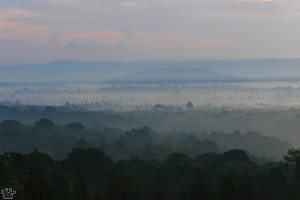
Morning fog over Ituri Forest, DR Congo (Zaire).

Morning fog over Ituri Forest, DR Congo (Zaire). |
Travel in tropical forests
Micro-guide for beginners
Russian version
The high points of a rainforest trip are the moments
when you enter the forest and when you get out of it.
A. Fidler. Call of The Amazon
2003-2012
Every person interested in Nature should visit the tropical forests (hereafter TFs) at least once in the lifetime. It has to be a relatively long trip: unlike African savannas or North American national parks, TF is not an easy place to see wildlife. In your first few days there, you'll probably see nothing but ants, butterflies, mosquitoes, and a few birds. Being able to see more takes time and skill. I've spent more than three years in TFs of the world, and now I sometimes manage to see 20-30 species of mammals in one night, not to mention lots of other things. But it still requires a lot of physical effort, and I still see nothing interesting on some nights.
The information below refers to places I'm more or less familiar with: South and Central America, the West Indies, Tropical Asia with surrounding islans, New Guinea, Australia, Africa and Madagascar.
Note. Any travel outside your house is potentially dangerous, and may result in injury or death. If you read the text below and something bad happens to you anyway, it's not my fault.
General recommendations
Possible problems
Where is everybody?
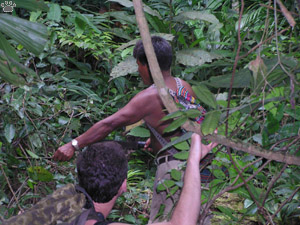
Clearing a forest trail, Darien, Panama. |
The first week in TF can be difficult. Your body needs time to adapt to heat and humidity. With each trip, the adaptation time will decrease, eventually to less than an hour. A few easy steps will make the adjustment easier:
- Try to spend the hottest hours (usually 10 to 17) in a shade, or, if possible, in the water. There isn't much to see in the forest at that time, anyway. It's best to sleep twice a day: from midnight to 4 o'clock and from noon to 16.
- Try to wear as little clothing as possible. I usually wear only shorts, or nothing at all if the place is remote enough. At night you might need a T-shirt or even a light coat: it might be chilly, besides, malaria-carrying mosquitoes are mostly nocturnal. NEVER wear any underwear: it will be constantly wet, and a half-hour hike will make you rub off sore so badly that you'll not be able to walk for days. It's better not to wear any hats, either. For women, a loose shirt is better than a tight top.
- Limited exercise helps your body adjust: swim whenever you can, walk around in the morning and in the evening. If you can get some sex (usually you can in the tropics), don't be lazy - go for it.
- Try to avoid long hikes in you first week in TF. If you have to walk for long, keep the weight of your backpack to a minimum. You need less food in the tropics, because you don't have to spend energy to keep warm there. A light coat and a plastic raincoat is all spare clothing you'll need in the lowlands. If your hike is less than ten days long, but your backpack is heavier than 10 kg (22 lb.), you are carrying something you don't need.
- Western travelers tend to follow the stupid advice of most guidebooks and drink too much water in the tropics. It makes you permanently sweaty, stinky, and tired, your hands and feet get swollen, and your clothes rot on you. It's better not to drink at all during the day, like native hunters do. Boil yourself some water or tea in the morning and in the evening, or drink some coconut milk if available. Carrying bottled water only makes sense on short hikes, no more than two-three days long. But be careful: dehydration is also dangerous, particularly for women (it might cause urinany infection). If your urine becomes dark, it means you are not getting enough water.
- Another common mistake is using heavy boots. I prefer light sandals, or walk barefoot if the trail is good enough. Boots cause skin and circulation problems, sometimes permanent. Besides, they make you careless when you walk. If you wear sandals or no shoes at all, you'll soon learn to watch your step all the time, which is a good habit in TFs. Don't forget a spare pair: like all equipment, shoes tend to fall apart rapidly in the tropics. Wear them for a while before the trip, make sure they don't disintegrate or get too slippery in the water, and the soles are thick enough to protect you from thorns and sharp rocks. It's not a bad idea to test ALL your equipment before leaving home.
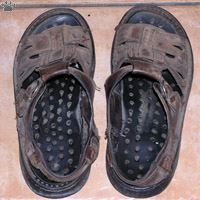
These sandals (made by Eurotop, Italy) survived a year of travel in the Americas, Asia and Africa. |
- Avoid air conditioners. You'll get used to heat much faster if you don't mess with the adjustment process by constantly moving in and out of cooled spaces.
- Try to walk quietly and effortlessly. Breaking through the thickets with a machete is only needed if you are leading a caravan of pack mules or overloaded backpackers. If there are native hunters in the area, ask for a permission to follow them around for a while. Note how they move, what they pay attention to, how they choose the way. Don't hurry, step softly, avoid disturbing the vegetation. If you make no sound at all while walking, you are doing it right.
- It's better to make frequent stops, 20 minutes every hour or so. Use that time well: relax completely and watch the forest around you. You can see a lot just by being still and paying attention.
- Don't be afraid of rain. It's very difficult to catch a cold in the tropics, unless you are high in the mountains. Water in TF lakes and rivers is usually hard. An hour-long walk in the rain will clean your hair, skin, and clothes better than a long battle with soap and shampoo.
 |
gap | 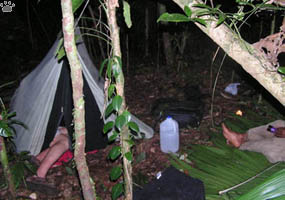 |
| My tent, Darien, Panama. | ||
Most people use hammocks in TFs. I prefer a tiny tent that I've made ten years ago, and never had to repair. It looks like an equal-sided triangle in cross-section. Its front and back panels are made of black chiffon, so it has good ventilation, and I can see what's going on outside without being visible. It has two very long (no less than 6m/20') ropes attached to the roof (finding two trees is never a problem), but its side strings are not normally used. I spread it out by putting all other items from the backpack on the sides of the floor. If it rains, the tent gets wet, but all the stuff under the side walls is in plastic bags. I put my raincoat under the sleeping bag, so it also stays dry. If it's very windy, the tent can be set lower, so the wind presses it to the ground instead of blowing it away. To dry the tent, I simply get everything out and hang it higher. The tent is only 400 g, it takes 2 minutes to set and 2 minutes to pack. It is closed by zipper/Velcro combination which is absolutely insectproof. Light green color is good for safety.
All of the above is not as important as your psychological condition. TF is the most interesting place on Earth, but to really enjoy it, you have to learn its ways. It takes some work, but eventually you'll be able to enjoy it a lot - if only you can survive it long enough.
 |  |  |
| Freshwater stingrays, Rio Manu, Peru. | ||
Long gone are the wonderful times when TF travelers had to worry about cannibals and man-eating tigers. Some people still manage to get eaten, but the chances of such a thing happening are so slim, even mentioning it is just a joke. There are, however, some real dangers to avoid:
- Malaria is the only disease you have to think about all the time. There are lots of websites and chatrooms discussing the relative qualities of various prophylactic pills. But all those pills have to be taken for at least a month before the trip, all of them are bad for your health, and none provide absolute protection. It's a complicated problem, and I might be very wrong about it, but I've managed to avoid malaria simply by using mosquito repellent - everywhere except Africa and coastal Madagascar, where more than two thirds of local population might be infected. It's imperative to use the repellent at night, but you might consider applying it during the day, too: TFs have many other unpleasant insects, especially in the vicinity of human settlements. You can decrease your chances of catching malaria by traveling during the dry season. Even if you rely on insect repellent, you should carry anti-malarial drugs with you: treatment works much better if you start it immediately after the first attack. Use different pills for prophylactics and for treatment. Currently, Lariam is the best prophylactic drug for most areas, while Coartem is the best one for treatment (it's not toxic, and there are no resistant strains of parasite yet, except in one part of Indochina). After getting rid of parasites in your blood, you have to undergo treatment with Primaquine to make sure they don't survive in your liver. Otherwise it might start all over again a few weeks or months later. Note that some African cities, even such modern-looking as Nairobi, have more malaria-carrying mosquitoes than any jungle.
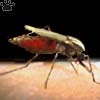 Anopheles gambiae, Entebbe, Uganda. |

Only Anopheles mosquitos can carry malaria. They can be easily recognized by the way they hold their abdomen (right). |
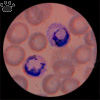
My blood sample with two malaria trophocytes, Kenya. |
- Dengue fever is now very common in many tropical countries, mostly in cities and towns. Again, your best protection is a repellent with high DEET content. Take a lot of it with you: you'll be swimming and walking in the rain all the time. Only on very long trips (more than 4-6 months) can DEET cause serious health problems.
- Yellow fever is also mosquito-born, but the best protection is a shot - works for ten years. Keep your vaccination certificate: some countries require it. Yellow fever is now mostly limited to West Africa and, to much lesser extent, Amazonia. Monkeys get it, too, so there is some chance of getting infected even far from villages.
- Mosquitoes, sandflies, blackflies, bugs, gnats, ticks and mites can also infect you with river blindness, Chagas' disease, leishmaniasis, elephantiasis, and other nightmarish plagues, so DEET is your best friend. Fortunately, most of those diseases are relatively rare. More information can be found at http://www.lonelyplanet.com/health/infections.htm and http://travel.roughguides.com/health/atozsplash.html. Before the trip, make sure your tent is ABSOLUTELY insectproof. One of the tests is to set it up near an anthill and put some bait inside. The repellent has to be tested, too: some of them get washed off by sweat after an hour of walking. US Army repellents are usually fairly good. To minimise exposure to insect bites (and also to make their life easier when visiting unfamiliar cities, flying small planes etc.) girls can use a little device that allows them to urinate standing up, without taking their pants off. See http://www.freshette.com/photos.html for details.
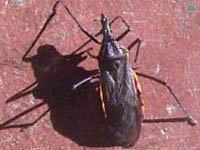
Kissing bug is a vector of Chagas' disease in Latin America. |
- There are lots of interesting parasitic worms in the tropics. You can minimize the possibility of getting infected by: drinking only boiled water; eating only carefully washed or peeled fruit; swimming in stagnant water only if the place is very remote and there's no choice; never swimming in or downstream from cities, large villages, and places where cattle drink; never sleeping on the ground near human or animal trails, piles of animal dung, and watering holes. In Africa, avoid swimming near reedbeds, where bilhartzia might be present, or wear a wetsuit.
- Usually, bloodsucking insects are less of a problem in TFs than in boreal forests or tundras. During the dry season there might be none at all. In Asia and eastern Madagascar, some people freak out when first fed upon by terrestrial leeches. Leeches are not known to transmit any disease, but they can suck a lot of blood if there's a lot of them. The bites of Madagascar leeches also itch. DEET repels them, but it has to be applied more frequently - sometimes every two hours.
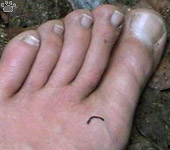 |
Gap | 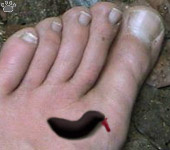 |
| Terrestrial leech, Ranomafana, Madagascar. | ||
- Chiggers are common in Central and South America; they are also present in parts of Africa. They are so tiny that many people can't see them. Most are red or white. They live in tall grass in forest clearings and meadows, or in dense undergrowth. If they get on you, they climb up your legs until something stops them - most often your belt, or a skin fold. Then they bite. The bite sites can itch for weeks, sometimes months. It might be a real problem if you have to return to civilization during this time, because you have to scratch in places not generally considered scratchable in public. DEET helps, but not much - try combining it with permetrine-based repellents. Chiggers only bite in places covered with clothing, so in uninhabited forests you can simply walk naked. If there's a lot of chiggers, wear long pants, and put DEET in a thick layer on your legs above the lower ends of the pants to make a barrier. Wash yourself with soap after walking in chigger-infected places. If you get bitten a lot, cut your fingernails short to avoid damaging the skin by scratching. Juice of banana leaves helps to bring down the itching.
- In Asia you might also encounter wood chiggers. They are similar to chiggers, but even smaller, and live in rotten wood. A piece of plastic would protect you if you have to sit on fallen trees or logs.
- In sandy areas of Latin America you might encounter chigoe fleas. They are tiny insects that burrow into your skin and remain there for a week, causing severe itch. The bite looks like a pale spot with black dot in the center (chigger bites often have red dot in the center). To prevent chigoe attacks, cover your feet with DEET all the way to your toes.
TFs of tropical America are also home to human botfly (torsalo). It is a large fly that catches small flies and mosquitoes and lays eggs on them. If the small fly or the mosquito later lands on human body or clothes, the egg hatches, and the larva burrows into the skin. It will remain there for up to eight weeks, and grow to impressive size. To prevent this, sterilize your clothes after drying them outdoors by leaving them for half an hour in direct sunlight in a closed plastic bag. If you get infected by a botfly, be careful not to kill it (it would cause severe inflammation). Small larvae can be removed by a syringe without a needle (especially a large syringe from a snakebite kit). To get rid of a large larva, tie a peace of meat to your skin. The larva will burrow into the meat in search of breathing air, and can be removed. I have to note that I've never seen a human botfly or its larva in all my travels.
- In some places, such as the Amazon, sweat bees can be a problem. They don't sting, but tickle a lot, especially if thousands gather to lick salt off your skin. Try to get used to them and ignore the little buggers, or put on a T-shirt if you have one.
- There are some poisonous animals and plants in TFs, so it's better not to touch things. Avoid touching tree branches without looking at them first: some are covered with thorns or ants. Some species of bamboo (especially in the Philippines) and other plants are covered with very short reddish or brown bristles, which cause acute pain and/or itch if touched. Avoid hairy nettle-like leaves, and trees with black sap flowing out of cracks in the bark. Mountain forests of Africa can have a lot of stinging plants - some will even get you through light clothes. Wear long sleeves in such places.
- Don't touch HAIRY CATERPILLARS, bright-colored beetles, and ants. Some tropical ants can sting or bite through the skin, especially army ants and fire ants (red with pointed rear ends).
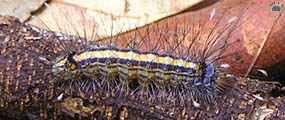 Lymantrid caterpillar, Darien, Panama. |
- Snakes are usually difficult to find in TFs. You are unlikely to see big ones, but there is a small chance of stepping on a well-camouflaged pit viper, especially if the trail is covered with dry leaves. Watch your step. Don't put your hands in tree hollows, burrows, leaf or hay piles, under logs and rocks, unless you are sure there are no snakes, ants or scorpions there. In Africa, don't get closer than 3 m (10') to any snake unless you are wearing eyeglasses or you are sure it's not a spitting cobra.
- Wash your hands after handling frogs, toads, salamanders, millipedes, snails, slugs, or terrestrial flatworms. If you can't wash your hands immediately, try to keep them away from your face.
- It's better to swim in a swimsuit or shorts and a T-shirt, because small fishes often nibble on your nipples and other protruding parts. Piranhas, electric eels, electric rays, candiru catfishes, stingrays, river sharks, anacondas, caimans, and other South American freshwater horrors are not a real danger (contrary to what every local will tell you). You'll hear stories about candirus invading people's urinary tracts at every campfire between Darien Gap and Iguazu Falls, but there have been only three documented cases in all of South America, all with people swimming without swimsuits.
- In places where dangerous species of crocodiles occur (African savannas, national parks of India and western Madagascar, river deltas and mangroves of SE Asia and Australia), it is better to choose places with clear water, and swim wearing a mask. Crocs might attack you when you float on surface, but diving towards them makes them turn away.

A perfect river for swimming, Masoala, Madagascar. |
- Some travelers complain that while in TFs, every tiny scratch or cut on their skin gets infected. I had such problems only once, and got healed by swimming in the ocean. If you are prone to these things, bring a variety of broad-spectrum antibiotics.
- Most visitors from non-tropical countries get diarrhea in the tropics. Don't panic. Usually it stops by itself within a day or two. Don't take pills unless it gets really bad or lasts for many days. Imodium doesn't cure diarrhea, it only stops the symptoms for a while, so it should only be taken before long bus/plane trips, etc. To avoid diarrhea, don't eat diary products (especially homemade ice-cream), food of uncertain freshness or covered with flies, fruit and vegetables unless you can wash or peel them. Avoid expensive restaurants and dishes. Buy stuff from street vendors only if it's been recently boiled or fried. Anyway, diarrhea is usually a problem in cities and villages, not in the forest.
- In many protected areas of Africa, India, Sumatra and Nepal, walking is not allowed because there are "dangerous animals" around. In truth, a night walk in Nairobi is much more dangerous than in Serengeti. When approaching large animals on foot, watch their reaction carefully. If an elephant starts to rock and spreads its ears, or a buffalo moves its ears backward, or a rhino turns sharply to face you, it's time to politely step back. Getting close to lions and tigers is a bit of an art: never turn your back on them, and make sure they know you see them and aren't afraid. If you don't feel comfortable walking up to a pride of lions or a tiger at a fresh kill, better don't do it at all. If you run into large mammals at night and they don't go away, pointing a strong flashlight at them might make them leave. Some animals don't look dangerous, but require certain respect: hippos, bears, large porcupines, wild pigs, white-lipped peccaries, ratels, skunks, and zorillas.
- Caves with large bat colonies have their own dangers: ticks and bedbugs sometimes fall on you from the ceiling; also, there've been cases of people contacting airborne rabies. If you can afford (or get someone to pay for) rabies vaccination, get it. It would also allow you to work/volunteer in zoos, wildlife rehabilitation centers, etc.
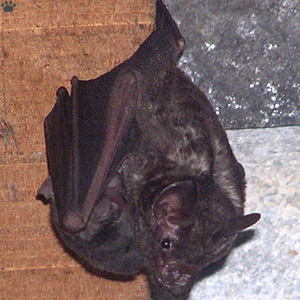
Vampire bat (Desmodus rotundus) with a baby under its armpit, Cerro el Avila, Trinidad. |
- It is very easy to get lost in TF, especially if you are not used to navigating there. Each jungle camp has a story about a tourist who walked ten feet away from the clearing and wasn't found until three months later (if at all). Many of these stories are true. Before you start exploring the area, memorize the map: what is the lay of the land, which way to go if you get lost. If you do get lost, always aim for linear objects (rivers, roads) rather than single points (villages, camps). If you have no idea which way to go, find a creek and follow it to the river. Then make a raft or swim downstream. Sooner or later you'll get to a village. Besides, you can be seen from a helicopter on a riverbank, but not in the forest.
- The sun always rises in the east and sets in the west. At noon, it can be in the north, south, or straight overhead, depending on the latitude and the season. On the first day of your trip, find out where it is at noon in that area at that time of year. If the sun is high overhead, it might be difficult to determine where it is related to the zenith. Tie a pebble or a nut to a piece of thread or a shoelace to make a perfect vertical, then drive a stick vertically into the ground to see which way it would cast the shadow. At night, stars rise in the east and set in the west. The Big Dipper and Cassiopeia are always in the northern part of the sky; the Southern Cross and the Magellanic Clouds are in the southern part. The Little Dipper is directly in the north, but you can't see it in most TFs.
- NEVER leave camp without a compass, a knife, a lighter and a flashlight. GPS users sould be particularly careful: their navigation abilities often deteriorate, while the magic device might not work under dense canopy, or run out of batteries. Small GPS devices are better than expensive ones: most additional functions are useless in the tropics, and a heavy device is more likely to be left in the camp when you walk into the forest to take a leak.
- And now, the most important advice. TF IS NOT A PLAYGROUND. No swinging on lianas, diving from rocks, tree climbing without proper equipment. Logs on the trail should be stepped over, not jumped over. Leave all athletic games until the last day, and play them within 500 feet from a bus stop or a runway. Be careful with machetes, and ALWAYS watch your step. Dragging a person with a broken leg or a deep wound along slippery forest trails isn't much fun, and your sores will be immediately attacked by meat-eating flies and other interesting guests.
 |
gap | 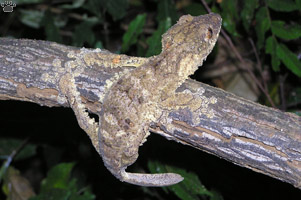 |
| Uroplatus geckos, Marojeja, Madagascar. | ||
At first it will seem to you that there is no wildlife in TF, except for some invisible crickets. That's not true: TF is packed tight with all kinds of creatures, you just have to know when and where to look:
- Forest animals are usually most active for a few hours after sunset, but in places with little or no human presence some would start hunting in late afternoon. Birds begin to wake up about an hour before dawn, and are most active until 2-4 hours after sunrise (less than an hour in the Philippines). So, try to spend your evenings, early nights and mornings in the forest; late nights and days - in a hammock, a tent or a river. Only in the immediate vicinity of tourist camps and villages, the best time is after midnight, when people go to sleep and the animals can finally come out.
- Many frogs, snails, and insects can only be seen just before rain, during the first hour of rain, or for half an hour after rain.
- I usually try to combine active and passive search. Walk around for half an hour, sit near a trail or a stream for a while, walk again. Always try to walk a trail at least once in daylight before going there at night. All-night watches only make sense in really good locations: mineral licks; flowering or fruiting trees; logs forming natural bridges across streams; recently fallen large trees; porous limestone outcrops; banana and oil palm plantations if they are surrounded by forest or abandoned; trails following rivers, or cutting across river bends, or connecting two forest patches; major trail junctions.
- Don't always walk on trails. Narrow forest roads can also be good for night hikes or drives, especially if there is good moonlight and no traffic. Some places (Gunung Mulu in Sarawak, La Selva in Costa Rica) have paved trails or boardwalks - these are especially good for spotlighting, because you don't have to watch your step.
- I like walking along forest streams, especially in dry season. The shores are often overgrown, but you can wade along or swim. In the Amazon, rivers meander a lot, so sometimes you can swim downstream for miles and then get to within a hundred meters from the starting point. In some parts of Asia, you have to be more careful because of crocodiles - try boating instead of swimming.
- TF rivers and lakes are full of colorful fishes, turtles, and other creatures, including some large animals such as river dolphins and anacondas. Always have a mask and a snorkel at hand. Finding a place with good visibility is often difficult. During rainy season, snorkeling in flooded forests can be interesting. You'll see different animals at night - bring a small underwater flashlight.

Hippo underwater, Tsavo West, Kenya. |
- Probably more than half of forest species live high in the canopy. Trying to see them from below soon causes severe neck pain. Some animals descend a bit along roads, riverbanks and forest edges; others stay high up all the time. There are many ways to get into the canopy yourself. Some require special equipment, others are just difficult and/or dangerous. The easiest ways are to find a steep slope with good canopy lookouts, or to use some of "canopy walkways" and "canopy towers" which are now becoming increasingly popular in TF parks and reserves. Most of these walkways and towers are overcrowded during the day, but can be totally deserted at night or early in the morning. The best I've seen so far were a small tree platform at Danum Conservation Area in Sabah, canopy towers in Jatun Sacha and Napa Wildlife Center, Ecuador, and watchtowers in Saiwa Swamp, Kenya and Lekedi Park, Gabon.
- Reliable light source is the most important piece of equipment. Take a lot of spare batteries and two-three LED flashlights. For night walks I usually use a small headlamp (which I keep turned on most of time, except on moonlit roads) and a larger flashlight (which I only use occasionally). The small headlamp allows you to see the eyeshine of animals without scaring them away; the larger flashlight can be used to get a better look at an animal you've found, or to look through the tree crowns around forest clearings.
- It's good to have binoculars with some kind of zoom. They should have wide view angle (to follow birds in vine tangles, for example), but enough magnification to see lizards in the canopy 40-70 meters above ground. At night, you'll have to use binoculars with a flashlight - practice it in advance. Headlamp also takes some getting used to.
- Never pass a cave without exploring it. Small and large caves often have different inhabitants, even if they are located in the same area. Depending on the geographic region, you can see cave swiftlets, swallows, oilbirds, giant spiders and crickets, snakes, rats, fishes, salamanders, millipedes, toads, etc., not to mention bats (sometimes more than 30 species in one cave). To get a better look at bats without scaring them away, try putting some kind of red filter on your flashlight.
- Bats and other animals can also be seen (more often at night) on the underside of bridges (especially in Panthanal), in road culverts, abandoned buildings and attics. During the day, bat colonies inside walls and under roofs can be found by the sounds they make, the smell, or the piles of guano underneath. Some bats spend daytime on tree trunks, palm fronds, in bamboo trunks, or in "tents" made of banana and palm leaves. Large leaves are also good to look for insects, tree frogs, and lizards at night.
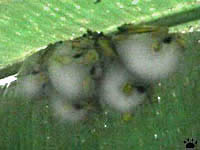 Bats in a tent made of banana leaf, La Selva, Costa Rica. |
- The trunks of very large trees and the ground around them are good places to search for reptiles and small mammals. Look also into burrows, under loose tree bark, in rock niches and cracks, in old termite and bird nests. A small mirror attached to a piece of wire can be used to look inside woodpecker holes and other narrow spaces. If a hole in the tree is too high, try scratching the trunk - sometimes the inhabitants will look out. Be careful: snakes, bees and wasps often live in tree hollows. Carry a small flashlight with you on daytime hikes, too.
- Large mammals are usually less common within a few kilometers from villages, but there are some exceptions. Park ranger stations, tourist camps, ancient ruins are often visited by relatively tame animals. Gede Ruins in Kenya, old Maya cities such as Tikal in Guatemala and Hormiguero in Mexico can look like zoos sometimes. Smaller carnivores, rodents, and tree shrews regularly visit garbage dumps. Some garbage dumps in places like Ngorongoro (Tanzania) or Murchison Falls (Uganda) can attract up to ten species of mammals (including large ones) in one night, and up to 30 species of birds during the day. Toads, geckos, owls, and numerous interesting insects can be seen in the vicinity of street lights and public toilets. The brightest street lights are often checked every morning by bird flocks looking for moths and winged termites. For some reason street lights in mountain TFs tend to attract more large moths than those in the lowlands. Some of the best places to see beautiful moths and associated birds include the hotels area at Mt. Kinabalu, Sabah; Machu Picchu in Peru, remote gas stations in Southern China, Wolong Panda Reserve breeding facility in Sichuan; research station in La Selva, Costa Rica; street lights in Kamenushka, Ussuriland; and campsite lights in Ranomafana Nat'l Park, Madagascar. Public toilets in Chaco National Park, Argentina and in Everglades, Florida sometimes have more than ten species of amphibians.

Bearded pig checking a jungle camp for food scraps, Sungai Kinabatangan, Borneo. |
- Bird feeders occasionally attract mammals at night (such as bats and olingos in Monte Verde, Costa Rica, and tree porcupines at Rancho Grande, Venezuela). If you are planning to spend a few days at the same place, you can make your own feeder by leaving a pile of bananas in the forest, or by tying a roadkill goat to a tree. Leave enough food, otherwise ants will carry it all away. Try leaving a thin layer of sand around the bait - it will allow you to check for tracks later. Flying foxes, kinkajous, olingos, lemurs, civets, day geckos and many other animals can be attracted by hanging peeled bananas or oranges from trees.
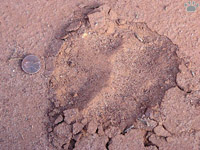
Cougar track on a sandy trail, Calilegua, Argentina. |
- Local people can tell you where salt licks are located - they are often on roadsides (such as bongo/elephant licks in Aberdare, Kenya), or on river banks (such as macaw colpas in Manu, Peru), and easily accessible. Some salt licks are in caves, such as the famous ones on Mt. Elgon, Kenya.
- If you encounter army ants, follow them for a while. Numerous insects and spiders trying to escape the ants attract many species of birds, some of which can virtually never be seen away from the ant swarms.
- Some rubber toys make sounds similar to the calls of small rodents. Such toys can be used to attract owls and small mammals.
- Many small animals hide under rocks and logs. Not all logs are good, though. An ideal log has been in place for a long time, but is not yet too rotten or overgrown. Many frogs, snakes, lizards inhabit the upper 10-30 cm of soil under logs.
- TF soil is usually hard, with lots of tree roots. If you find a place with soft soil, such as a streambed, take a shovel and look for subterranean fauna - sometimes there's a lot.
- At night, interesting invertebrates and frogs can be found on the upper side of logs, on tree trunks and roadside slopes. In Central and South America, some unusual creatures inhabit the leaf bases of bromeliads; on Madagascar - pandanuses.
There are countless other methods, and you will probably come up with some of your own eventually. Just try to spend as much time as you can in the forest, and always keep looking. Sometimes you spend a whole night on a trail and see nothing, but next night the same trail is full of wildlife.
Good hunting.
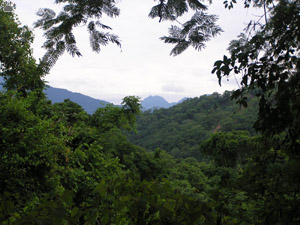
Andean foothills in Calilegua, Argentina. |